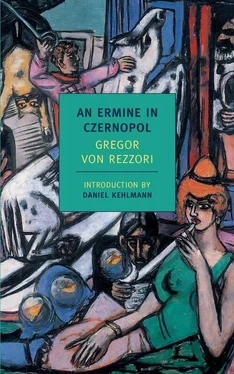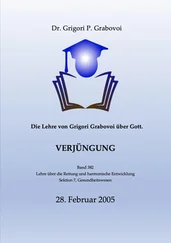The plaza was long and narrow. At the top stood the town hall: a typical provincial administrative building with a banal façade, fronted by a pitiful esplanade where ragged newspaper boys scuffled on cobblestones copiously sprinkled with the spat husks of sunflower seeds, like the feathers of a guinea hen. The streetcar station kiosk across from the monument served as a gathering place for loafers and layabouts; every half hour a policeman in a chocolate-brown uniform would drive them away, but within minutes they would be right back in their groups, jabbering away without restraint. Next to them, a row of shoeshine boys hammered their caked-up brushes against their boxes. Over the roofs of the far row of buildings, the dome of the great synagogue — a version of Solomon’s Temple that reflected the Orientalist taste of the fin de siècle — towered melodramatically into the sky. On the near side, at ground level, were two credit-and-exchange banks, a cinema, several haberdasheries, and three kosher eating houses, as well as Kucharczyk’s Café and Confectionary, where, as soon as the weather turned warm, the tables and chairs were set up on the sidewalk outside the mirrored window displays. Enclosed by a number of potted oleanders, this preserve was the meeting place of Czernopol’s elegant society, the egress and turning place of the daily procession that brought half the city into motion in the early midday and evening hours.
If you allowed yourself to be carried off by this daily current, you would find the streetcar, or “line,” as it was generally known, off to your right, cutting straight up the main street as it ascended, clambering past the shops, bars, credit-and-exchange banks, cinemas, and kosher eating houses, until it reached a small park outside the buildings of the provincial government at the peak of the rise. Long after the collapse of the monarchy, that place still exuded the subdued and self-assured official elegance that was projected by the governmental buildings from the time of Joseph II, as strongholds of proper order. The line continued for another few hundred yards: under the canopies of mighty chestnut trees, past the high iron pickets of the fence designed to protect the basilica of St. Miron of Czernowitz — a jewel of ancient Slavonic church building filled with the most magnificent frescoes — from destruction and desecration. Then the red streetcars came rattling out of the green shade of the trees, vigorously ringing their bells as they sped into the harsh glare and reentered the traffic of a main road leading out of town, ultimately coming to a stop in front of the stepped terrace of the officers’ casino, opposite the entrance to the Volksgarten. There the line narrowed to a single track which ran, interrupted by two turnouts, toward the terminal at the southern edge of town, where the playing fields of the ethnically aligned sports clubs Mircea Doboş, Turnvater Jahn, and Makkabi adjoined the broad grounds of the cavalry barracks, and where, off to the side, isolated behind a solid wall, stood the gray building of the municipal asylum.
For years it was our passionate wish to be allowed to ride one of these red cars, even for just a short stretch, but we had to wait patiently until this wish was fulfilled — I no longer remember when. Because, as is so often the case, by the time our wish was granted, our desire had lost much of its fervor, and unfortunately its achievement had lost much of its worth — though by no means all. Incidentally, the reason for this ban was not due to any particular danger associated with using the streetcar — which really only would have applied to the steep section from the Ringplatz to the bridge over the Volodiak — but rather because of a near-manic fear of infection harbored by our governess, an Englishwoman by the name of Miss Rappaport.
Actually no one in our household really believed she was British, even if in some respects she was so Anglo-Saxon it verged on caricature. And it’s true: she was not born on the Isles themselves but rather on Gibraltar, the daughter of a Mr. Rappaport in the shipping business and a woman classified as an Anglo-Spaniard, but despite that she was every bit the clichéd colorless, gaunt, and prognathous English governess anyone could wish for. Naturally the story of her clearly complicated and scarcely typical background could not escape the attention of those who claimed to see through her all too well, so that in our family circle she was simply called “the Jewess,” and as such was never mistaken for anyone else, which was rather amazing, considering God only knows how easily that could have happened in Czernopol. People also took care to see that she did not come into contact with the dogs, who were very pure breeds, and for whom she felt a genuine British love. On the other hand, she was given nearly absolute control over our education. She placed great value in honing our English pronunciation into what she referred to as “the King’s English,” always with a respectful tremble that elicited ironic glances among the adults who happened to be present, as if her monarchic convictions amounted to a typical Jewish presumptuousness. Her method was the simplest and best: she had us repeat the same sentence for hours, and I will never forget the nuances she was able to detect and coax out of the simple construction: “Herbert was murdered.” From a tone of extreme indignation, such as only an English governess is capable of, through one of matter-of-fact declaration, up to a positively gleeful communication, we ran through the entire gamut of emotional possibilities under her inexhaustibly patient instructions, with all the gentle vocal variations and shadings of the vowels that merely hint at the r rather than let it be heard, and I am convinced that no language instruction was suited to convey the English character so purely as one that places the student in a position to pronounce, with fresh, bright-eyed assurance: “ Heh-bet wahz meh-dedd. ”
By the way, I mention Miss Rappaport not merely for the sake of it, but rather to show that Czernopol did have neighborhoods where an English governess didn’t stick out as a great eccentricity. I am talking about the villa district that ran along the northwest edge of the Volksgarten, where our town house was located. To be sure, most of the households there preferred French women, and more often than the Anglo-Saxon sounds you could hear a concerned cry coming through the pretty gardens such as Jacquot, Jacquot, qu’est-ce que tu fais? answered by an obedient little voice: Je joue avec les Rochlitzerkinder, mademoiselle! Of course Miss Rappaport didn’t let us out of her sight for even a minute, and if she did let us into the garden on cold days to “take our exercise”—she herself stayed inside, as sunny Gibraltar had made her sensitive to chilly weather — then we had to pull little wagons after us, the wheels of which creaked so loudly that she knew exactly where we were and that we were in constant motion.
But let us return to the Ringplatz, where I left you in front of the Kucharczyk Café, in the grip of the restless strolling, carried off to the left by the swirling procession, down the former Herrengasse, now renamed Iancu Topor Avenue, after a hero whose accomplishment was so obscure as to cause anyone to rack his brains. There you could feast your eyes on bona fide Jewish maidens as beautiful as Esther, Judith, or Salome, women whose lines were drawn by Beardsley and whose flesh was painted by Ingres; on Polish girls with catlike faces, watery blond hair, and small pinched lips glowing with passion; on almond-eyed Armenians with nobly drawn desert profiles, proudly swaying their heads on their beautiful smooth necks like camels in unruffled trot; or on Romanians whose apple-like freshness was covered by a soft down that the shadows made even more enticing. The marvelous mix of races — which in every case infused the soul, if not the blood — worked its charms. There were young men exhibiting the noble male proportions of Antinoös next to effeminate, angel-headed youths with magnificent luxurious jet-black curls framing their translucent pre-Raphaelite faces, but each and every one, male and female alike, spoke the same raw-throated, and agonizingly vulgar dialect that colored every language spoken in Czernopol, and whose only musical justification, if I may call it that, lay in the deadpan delivery of witty anecdotes or in springing the punch line to dirty jokes.
Читать дальше












